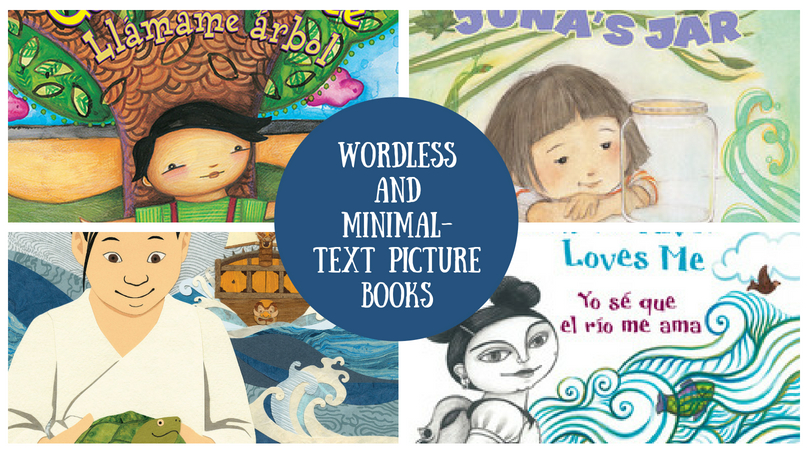In this age of rigor, text complexity, and higher standards for younger and younger readers—why do wordless picture books continue to be so popular?
Wordless, or minimal-text, picture books:
- enable children to explore the art of storytelling and world-building
- are a wonderful medium for expression and creative thought
- are a natural introduction to inferencing, a metacognitive skill that is often taught in the later grades
- help readers practice reading facial cues and studying visual context clues for vocabulary and plot development
- engage visual learners or visually-motivated readers
- alleviate struggling readers who may feel overwhelmed by dense text and long print sections
- offer a launch pad to a lifelong love of other visually-rich formats, including comics and graphic novels
Why choose a wordless, or minimal-text, picture book for your next storytime?
 Children need to “read” the illustrations and interpret characters’ actions and thoughts with their background knowledge and clues from the illustrations to determine what’s happening in the story.
Children need to “read” the illustrations and interpret characters’ actions and thoughts with their background knowledge and clues from the illustrations to determine what’s happening in the story.
Wordless picture books boost children’s oral language, vocabulary, and embody features of print awareness without the text. Wordless picture books and consequent activities also appeal to older students, who have the opportunity to experiment with creative writing in response to the stimulating illustrations.
What do you do with a wordless, or minimal-text, picture book?
We’ve come up with some of our picture books that have less text and/or beautiful illustrations that you can use with children. When engaging with wordless picture books, it’s always helpful to:
- Take a picture walk. Make sure to look through the pictures prior to developing the story so that children are fully prepared to engage.
- Consistently ask questions that get children thinking in terms of the traditional narrative story arc: Who is the character? Where does the story take place? When does the story take place? Why is the character doing those things?
- Refrain from putting pressure on the child by requiring the story to make sense and match the pictures exactly. Wordless picture books are a way for children to use language in a way that best suits their current vocabulary and cognitive abilities.
- Work on prediction with children. Picture books are an ideal medium for students to practice predicting skills by thinking about what’s going to happen next. Before you turn each page, encourage children to anticipate the next sequence of events by using what they already know from the story and what would make sense.
- Have students dictate the story as a group to the educator or adult on the spaces underneath the images or on their own as part of a follow-up writing activity.
Here are our favorite LEE & LOW titles that you can use with or without the text:
One of our newest titles at LEE & LOW features Sun-sin who designs one of the greatest battleships in history and fulfills his dream of sailing the world. Cover up the text and have children imagine how Sun-sin, with the help of his beloved pet turtle, constructs the ship. The Turtle Ship inspires creativity and ingenuity in children and lends itself to children making their own structures inspired by the intricate paper collage.
Here is an imaginary tale of self-discovery told by a child who grows, learns about the natural world, embraces others, and is free to be who he or she is meant to be. This book is one of our books at LEE & LOW with the least amount of text. Read the words or cover up the text and focus on the feelings and emotions of the children in the book. Children can work on inferencing by examining the colorful illustrations. Encourage children to think about what the children in the book are representing and why.
Many children will relate to this story about friendship and longing. Juna, the main character, goes on magical adventures, by way of her special kimchi jar, in search of her best friend who has moved away. Have students think about the purpose behind Juna’s motives for traveling by relying on the illustrations.
Maya’s Blanket/La manta de Maya
This is another one of our books at LEE & LOW with exquisite illustrations that tells a gorgeous story. Maya’s cherished baby blanket made by her grandmother becomes old and worn over time. As she grows older, the blanket is continually repurposed as other items. Have children trace the journey of the blanket without the use of text and have them tell the story of why the blanket keeps getting recycled.
I Know the River Loves Me/Yo sé que el río me ama
This book is a great way for students to come up with a story revolving nature and water. I Know the River Loves Me does not have much text in the actual story, so it’s a great way for students to construct a narrative surrounding the main character and how she came to love the river.
Listed below are some additional resources about how to use wordless picture books with children at home, in your library, or classroom:
Sharing Wordless Picture Books
Creative Writing Through Wordless Picture Books
A Picture’s Worth a Thousand Words










